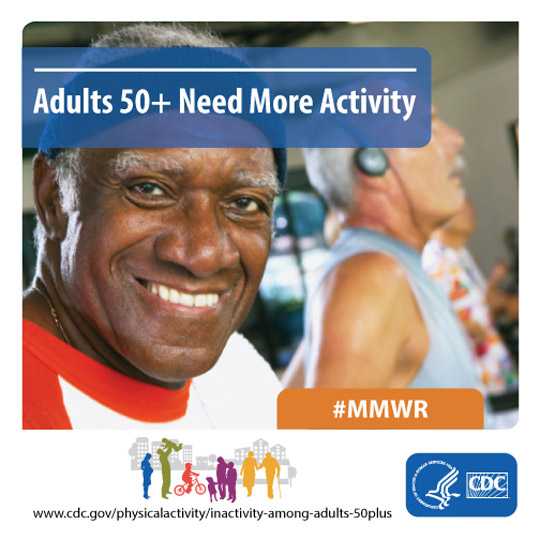Adults Need More Activity
Communities can help
Regular physical activity is vital for healthy aging. It can help delay, prevent, or manage many costly chronic diseases. Physical activity can also reduce the risk of premature death. Despite these benefits, a new study published by the Centers for Disease Control and Prevention (CDC) found that 31 million adults aged 50 and older (28%) are inactive. Inactivity is defined as not getting any physical activity beyond basic movement from daily life activities.
The study found that among U.S. states and DC, the percentage of inactivity:
- Ranged from 17.9% in Colorado to 38.8% in Arkansas.
- Was higher among women, Hispanics and non-Hispanic blacks, and adults with ≥1 chronic disease than their counterparts.
- Decreased as education increased and increased as weight status increased.
Helping inactive people become more active is an important step towards healthier communities. Many adults age 50 years and older want to be active but face barriers in their communities. Everyone, including federal, state, and local governments, transportation engineers and community planning professionals, and community organizations can play a role in helping communities offer design enhancements and healthy lifestyle programs to create a culture that supports physical activity.
For more information and the full press release, please visit Millions of adults 50 years and older are not getting any physical activity.
Contact Information
Spokespersons
Kathleen B. Watson, PhD
“By identifying which groups are more inactive, this report helps us better understand and address differences in inactivity among adults 50 years and older.”
“More work is needed to design and enhance communities to make it safer and easier for people of all ages and abilities to be physically active.”
Kathleen B. Watson, PhD – Epidemiologist, Division of Nutrition, Physical Activity, and Obesity (DNPAO), National Center for Chronic Disease Prevention and Health Promotion
Ruth Petersen, MD, MPH
“Adults who participate in any amount of physical activity can gain some health benefits. Helping inactive people become more physically active is an important step towards healthier and more vibrant communities.”
Ruth Petersen, MD, MPH – Director, Division of Nutrition, Physical Activity, and Obesity (DNPAO), National Center for Chronic Disease Prevention and Health Promotion
Related Links
- Physical Activity Needs for Adults
- Physical Activity Needs for Older Adults
- Physical Activity Builds a Healthy and Strong America
- Activities for Older Adults
- Overcoming Barriers to Physical Activity
- Measuring Physical Activity Intensity
- Designing and Building Healthy Places
- Community Strategies to Increase Physical Activity
- Step it Up! The Surgeon General’s Call to Action to Promote Walking and Walkable Communities
- Surveillance Systems Used to Track Physical Activity
- Health Impact Assessment
- State Indicator Report on Physical Activity, 2014
- CDC Vital Signs: Adults with Disabilities
- CDC Vital Signs: More People Walk to Better Health
- Mall Walking: A Program Resource Guide
- 2008 Physical Activity Guidelines for Americans
- National Physical Activity Plan
- The Community Guide
- Go4Life Campaign
- Safer People, Safer Streets Initiative
- EnhanceFitness Program
- Walk With Ease Program
- Smart Growth and Economic Success: Strategies for Local Governments
- Rethinking Streets: An Evidence-Based Guide to 25 Complete Street Transformations
- Page last reviewed: September 15, 2016
- Page last updated: September 21, 2016
- Content source:



 ShareCompartir
ShareCompartir







